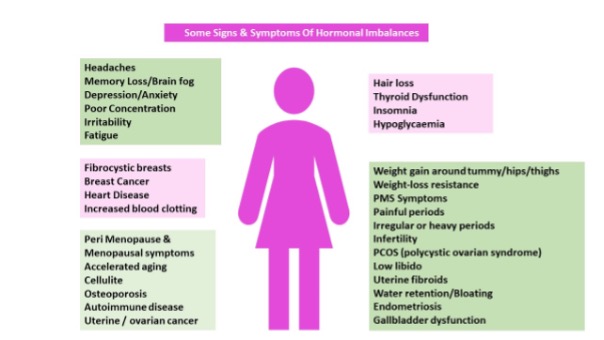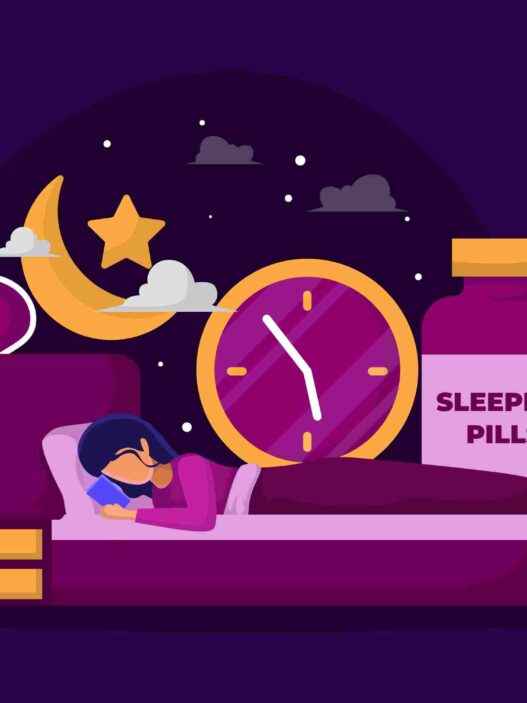What are xenoestrogens, the endocrine disruptors, and how do they affect women’s health by causing oestrogen dominance & hormonal imbalance? Check out ways to detoxify these environmental toxins and to balance your hormones through dietary & lifestyle changes.
What are Xenoestrogens, the Endocrine Disrupting Chemicals (EDCs)?
Endocrine-disrupting chemicals (EDCs) or xenoestrogens in the environment have become an increasingly serious problem in recent years. For women, exposure to these chemicals can have a range of impacts on our bodies, including disruption of hormones, which can lead to various health issues (1).
We are constantly exposed to a staggering 80,000 toxins in our environment daily. Research has revealed that these chemicals, found in foods, personal care, and household products, can disrupt our hormonal health by introducing hormone-mimicking molecules into our bodies, interfering with our body’s delicate hormonal regulation (2).
These endocrine disruptors, collectively known as xenoestrogens, will mimic the hormone oestrogen. These chemicals bind or block the oestrogen receptors on our cell membranes (3). Naturally, this negatively influences our hormone metabolism resulting in imbalances in hormone levels with potentially far-reaching consequences manifesting as vague symptoms or severe health concerns (4)
Furthermore, xenoestrogens can disrupt liver and gut health and negatively impact our body’s natural ability to excrete all toxins, thus making it more difficult to rid our bodies of these harmful chemicals, which eventually get stored within our fat cells. Too many xenoestrogens in our system alert the brain that there is an adequate amount of estrogen, leading to a reduction in the amount of natural estrogen our body produces.
In health, the endocrine system produces hormones, which regulate body processes such as growth, metabolism, and reproduction. Alas, women in perimenopause and menopause may be particularly vulnerable to the effects of these xenoestrogens because, at this stage in life, the body’s production of hormones, such as estrogen and progesterone is already on the decline or becoming imbalanced naturally. Xenoestrogens in the environment can only worsen this event by promoting even higher estrogen levels relative to progesterone, the hormone that balances the effects of estrogen.
What’s alarming is that these xenoestrogens can build up estrogen levels in the body, overwhelming our biochemistry. When our body can no longer effectively regulate its estrogen levels, this can lead to a phenomenon known as oestrogen dominance.
Are You Suffering the Effects of Oestrogen Dominance?
Oestrogen dominance is a term coined by Harvard hormone researcher John R. Lee. MD. Dr. Lee describes oestrogen dominance as a “condition where a woman can have deficient, normal or excessive estrogen, but has little or no progesterone to balance its effects in the body. Even a woman with low estrogen levels can have oestrogen dominance symptoms if she doesn’t have any progesterone”.
Oestrogen Dominance & Hormonal Imbalance: Signs and Symptoms
Oestrogen dominance can cause or contribute to these signs, symptoms, and conditions:
- Fatigue
- Weight gain and weight loss resistance
- Hot flashes
- Thyroid symptoms
- Immune deficits
- Autoimmunity
- Mood issues
- Sleep problems
- Painful, irregular, and/or heavy periods
- Pronounced PMS
- Breast tenderness or fibrocystic breasts
- Ovarian cysts
- Headaches
- Brain fog
- Poor skin health
- Infertility
- Increased risk of some cancers

As you can see, the consequences of ongoing exposure to these endocrine disruptors can be dire.
Unfortunately, these health risks are difficult to avoid due to the prevalence of xenoestrogens in our air, water, food, personal care, and household products. However, women should take proactive steps to minimize their exposure to environmental toxins to maintain their health and well-being.
The good news is that there are steps we can take to minimize our threat and exposure to these endocrine disruptors.
How Dysregulated Hormones Can Be A Major Stressor To Your Body?
We already know that long-term stress is harmful. However, are you aware that stress can come in many forms? For example, the long-term and ongoing effects of oestrogen dominance can cause a biochemical stress response in the body, and our bodies will experience a chronic ‘fight/flight’ reaction. Over time, chronic stress can negatively affect our hypothalamic, pituitary, and adrenal axis (HPA axis).
Moreover, EDCs have been shown to affect the HPA axis directly (5). This is problematic because this axis is where our hormonal and stress response systems interconnect to regulate our hormonal balance.
The stress hormone CORTISOL is produced in large amounts in response to chronic stress from whatever cause. Unfortunately, this further disrupts the balance of our sex hormones because too much cortisol disrupts the balance and metabolism of our sex hormones and can lead to a wide range of hormonal symptoms.
Whatever the type of stress we’re exposed to, it’s essential to understand that long-term stress is INFLAMMATORY and CATABOLIC (6). This is because stress breaks down our healthy body cells, tissues, and organs, which prevents healing, DNA repair, or detoxification, often leading to chronic disease.
What are some of the Xenoestrogens affecting our health?
Xenoestrogens can come from many different sources. Here are a few examples of the everyday EDCs you may encounter and what you can do to minimize your exposure.
Bisphenol A (BPA)
This is present in plastics.
Polychlorinated biphenyls PCBs
These pollutants are everywhere in the environment and have entered the food chain, especially in fatty fish.
Parabens and Phthalates
These are commonly found in household cleaners, food packaging, fragrances, cosmetics, and personal-care products (7).
PFAS chemicals
PFAS includes thousands of chemicals. These can be found in non-stick cookware, waterproof clothing, coatings on upholstered furniture and carpeting, and food packaging.
Butylated hydroxyanisole (or BHS)
BHS is commonly used as a food preservative.
Agricultural chemicals, Herbicides, and Pesticides
One of the most used pesticides worldwide is the Glyphosate-based herbicides sprayed routinely on food crops (8).
Synthetic hormones
These are used in some birth control pills and on intensively reared farm animals that become our staple food, including dairy, poultry, fish, and meat products.
Reducing Exposure to Xenoestrogens with Dietary and Lifestyle Changes
- Go for organic vegetables where possible, or if choosing regular produce, opt for those items that aren’t heavily sprayed. You can find a list online by the Environmental Working Group (EWG) called ‘The dirty dozen and clean fifteen’, which will tell you which product is the most heavily sprayed with pesticides (9).
- Choose organic or free-range poultry, meat, and dairy that haven’t been exposed to the routine use of hormones in the animal’s feed. Your local butcher often sells ‘clean’ produce that isn’t organic but can be a better option than intensively farmed meat.
- Choose wild fish as opposed to farmed (10). Or if you are very concerned about the pollutants in most oily fish and want to avoid eating them, please be aware that omega-3 fat is an essential nutrient. In this case, you could take a high-grade omega-3 supplement. Choosing a fish oil that has been tested for purity and has had most of the harmful toxins removed is vital. Such oils are certified as safely containing only the ingredients listed on the label.
- Replace processed foods with natural foods. The latter is not only more nutritious but also helps to reduce your exposure to harmful xenoestrogens.
- Eat more cruciferous and dark green leafy vegetables such as kale, broccoli, cabbage, and arugula (rocket). These vegetables contain potent plant nutrients that help us to detoxify harmful estrogen metabolites (11), thus helping to protect from health conditions driven by oestrogen dominance.
- Invest in a top-of-the-range water filter, such as a reverse osmosis water filter, to remove or reduce PFAS chemicals from your tap water.
- If possible, avoid personal care, make-up, and household products that contain “fragrance”, “parfum”, or “natural fragrances” as ingredients. Instead, opt for products that use essential oils for scent or are fragrance-free.
- Absorption of xenoestrogens via the skin is ten times more potent than taking them orally, as they go directly to the tissues bypassing the liver. Therefore, organic and ‘non-toxic’ cosmetics, personal care products, nail polish, and sunscreens are more likely to be free of EDCs and should be a preferred choice where possible (12).
- Research has found that fluoride can disrupt hormone metabolism. So, choose fluoride-free dental products instead (13).
- Replace cleaning products with white vinegar and baking soda. To create a mild cleaning solution, combine 1/2 cup of vinegar, 1/4 cup of baking soda, and 4-8 cups of hot water in a spray bottle. If desired, you can replace the baking soda with borax. A few drops of essential oil can be added to give the mixture a pleasant aroma. For deeper cleaning, combine baking soda and water to create a paste. Let it sit for a while to dissolve dirt and grime around your bath, floor tiles, or shower enclosure, and then rinse with water.
- Use only natural pest control and fertilizers in your home/garden.
- Avoid non-stick pans and kitchen utensils labelled with brands like Teflon, Scotchgard, Stainmaster, Polartec, or Gore-Tex. Instead, choose stainless steel or ceramic-coated cookware.
- Say no to optional stain-repellent treatments on new carpets and furniture. Many of these coatings are made with PFAS chemicals, as are fast food wrappers and packaging. This is another great reason to limit your consumption of health-depleting fast food.
- Replace the plastic with food-grade paper for packaging and glass or stainless steel for food and drink storage.
How to Improve The Detoxification of Estrogens and Xenoestrogens to Help Balance Hormones
Natural estrogen is a powerful hormone that can be both a blessing and a curse depending on how it is metabolized in the body. While estrogen itself is not harmful at the correct levels, the danger arises when specific metabolites of oestrogens and xenoestrogens are produced as the body breaks them down, ready for excretion (14).
These metabolites, or “dirty oestrogens,” can become “endogenous tumour initiators” and promote cancer. Metabolizing, detoxifying, and eliminating oestrogen and xenoestrogens from our bodies depends on various factors, such as diet, genetics, liver function, and the health of the body’s organs of elimination.
Eating a healthy, balanced diet with plenty of clean, fresh fruits, vegetables, and high-quality protein will help reduce your exposure to xenoestrogens and help your body detoxify and remove these EDCs from your body (15).
Additionally, lifestyle modifications, drinking plenty of clean water, exercising regularly, and managing stress in all its forms can also help to flush toxins from the body, avert oestrogen dominance and help keep your hormones balanced.
The Final Words
What measures have you taken to reduce your exposure to environmental EDCs? Furthermore, are you experiencing any symptoms of hormonal imbalance or oestrogen dominance?
Have you thought about using functional medicine to help with balancing your hormones? Functional medicine is an evidence-based modality that addresses the root cause(s) of a client’s health concern, optimising their health so that they can retrace their path back from debilitating symptoms and chronic illness to restored well-being and the ability to thrive (16).
Sources
- Kumar M, Sarma DK, Shubham S, Kumawat M, Verma V, Prakash A, Tiwari R. Environmental Endocrine-Disrupting Chemical Exposure: Role in Non-Communicable Diseases. Front Public Health. 2020 Sep 24;8:553850. doi: 10.3389/fpubh.2020.553850. PMID: 33072697; PMCID: PMC7541969.
- Bronowicka-Kłys DE, Lianeri M, Jagodziński PP. The role and impact of estrogens and xenoestrogen on the development of cervical cancer. Biomed Pharmacother. 2016 Dec;84:1945-1953. doi: 10.1016/j.biopha.2016.11.007. Epub 2016 Nov 15. PMID: 27863841.
- Combarnous Y, Nguyen TMD. Comparative Overview of the Mechanisms of Action of Hormones and Endocrine Disruptor Compounds. Toxics. 2019 Jan 24;7(1):5. doi: 10.3390/toxics7010005. PMID: 30682876; PMCID: PMC6468742.
- Eve L, Fervers B, Le Romancer M, Etienne-Selloum N. Exposure to Endocrine Disrupting Chemicals and Risk of Breast Cancer. Int J Mol Sci. 2020 Nov 30;21(23):9139. doi: 10.3390/ijms21239139. PMID: 33266302; PMCID: PMC7731339.
- Lauretta R, Sansone A, Sansone M, Romanelli F, Appetecchia M. Endocrine Disrupting Chemicals: Effects on Endocrine Glands. Front Endocrinol (Lausanne). 2019 Mar 21;10:178. doi: 10.3389/fendo.2019.00178. PMID: 30984107; PMCID: PMC6448049.
- Vasunilashorn S, Cohen AA. Stress responsive biochemical anabolic/catabolic ratio and telomere length in older adults. Biodemography Soc Biol. 2014;60(2):174-84. doi: 10.1080/19485565.2014.950722. PMID: 25343365; PMCID: PMC4347836.
- Calafat AM, Valentin-Blasini L, Ye X. Trends in Exposure to Chemicals in Personal Care and Consumer Products. Curr Environ Health Rep. 2015 Dec;2(4):348-55. doi: 10.1007/s40572-015-0065-9. PMID: 26342608.
- Myers, J.P., Antoniou, M.N., Blumberg, B. et al. Concerns over use of glyphosate-based herbicides and risks associated with exposures: a consensus statement. Environ Health 15, 19 (2016). https://doi.org/10.1186/s12940-016-0117-0
- https://www.ewg.org/foodnews/
- https://www.mindbodygreen.com/articles/worst-foods-for-hormone-health
- Zhao A, Jeffery EH, Miller MJ. Is Bitterness Only a Taste? The Expanding Area of Health Benefits of Brassica Vegetables and Potential for Bitter Taste Receptors to Support Health Benefits. Nutrients. 2022 Mar 30;14(7):1434. doi: 10.3390/nu14071434. PMID: 35406047; PMCID: PMC9002472.
- Environmental Working Group. EWG’s Skin Deep Cosmetics Database. 2011. Available: http://www.ewg.org/skindeep/
- Zhao MX, Zhou GY, Zhu JY, Gong B, Hou JX, Zhou T, Duan LJ, Ding Z, Cui LX, Ba Y. Fluoride Exposure, Follicle Stimulating Hormone Receptor Gene Polymorphism and Hypothalamus-pituitary-ovarian Axis Hormones in Chinese Women. Biomed Environ Sci. 2015 Sep;28(9):696-700. doi: 10.3967/bes2015.099. PMID: 26464260.
- Moore SC, Matthews CE, Ou Shu X, Yu K, Gail MH, Xu X, Ji BT, Chow WH, Cai Q, Li H, Yang G, Ruggieri D, Boyd-Morin J, Rothman N, Hoover RN, Gao YT, Zheng W, Ziegler RG. Endogenous Estrogens, Estrogen Metabolites, and Breast Cancer Risk in Postmenopausal Chinese Women. J Natl Cancer Inst. 2016 May 18;108(10):djw103. doi: 10.1093/jnci/djw103. PMID: 27193440; PMCID: PMC5858156.
- Hodges RE, Minich DM. Modulation of Metabolic Detoxification Pathways Using Foods and Food-Derived Components: A Scientific Review with Clinical Application. J Nutr Metab. 2015;2015:760689. doi: 10.1155/2015/760689. Epub 2015 Jun 16. PMID: 26167297; PMCID: PMC4488002.
- Beidelschies M, Alejandro-Rodriguez M, Ji X, Lapin B, Hanaway P, Rothberg MB. Association of the Functional Medicine Model of Care With Patient-Reported Health-Related Quality-of-Life Outcomes. JAMA Netw Open. 2019 Oct 2;2(10):e1914017. doi: 10.1001/jamanetworkopen.2019.14017. PMID: 31651966; PMCID: PMC6822085.
Featured Image Credit – Dreamstime LLC

Marie Cherrett BSc. NutMed, CFMP mFNTP is a registered Functional Medicine Nutritionist. Marie has an in-depth understanding of the complex relationship between disease/chronic health problems and nutrition and lifestyle. Marie is the founder of Your Healthy Hormones, an online service transforming the lives of women suffering from hormonal imbalances. She helps her clients go from feeling bloated, irritable, and tired to looking and feeling fantastic, so they can return to being their best selves. https://www.linkedin.com/in/mariecherrett/












